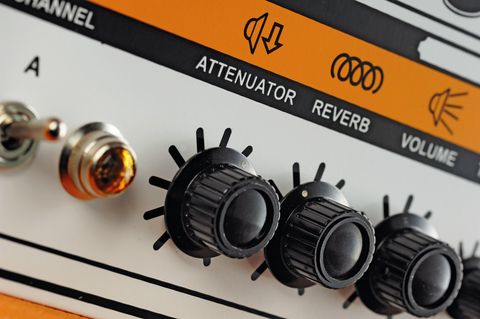The bone-crunching slab of sonic mayhem otherwise known as the Thunderverb 200 is a wonderful amplifier, but many players with more modest power requirements have been pinning their hopes on the appearance of a lower-powered version. Hey presto, here it is.
The Thunderverb 50 consolidates this new range from Orange, with the same basic preamp design as its larger brother, but featuring a 50W output stage powered by a pair of EL34s. Flexibility and power are still the Thunderverb 50's middle names though, as we'll see.
Like all Orange amplifiers, the Thunderverb 50 is built like the proverbial brick outhouse. A thick plywood sleeve encases a tough white powder-coated steel chassis with a full-height steel front panel and a steel grill at the rear to protect the valves.
Normally, you'd see a couple of internal chrome grab handles to aid in removing/replacing the chassis, however the addition of a reverb tank screwed to the roof of the sleeve means the Thunderverb only has one.
Inside the chassis, all the electronics are supported on one very large printed circuit board, including front and rear panel controls and all the valve bases. What little wiring there is has been neatly tied back and the high quality components add to the impression that the Thunderverb is one very well-sorted amp.
The controls are straightforward, although there are a couple of typical Orange twists. This is a two-channel design, with two sets of gain and master volume controls. Where you'd expect one channel to be dedicated to lead and the other to clean/crunch, the Thunderverb has similar amounts of gain available on both channels, making either suitable for rhythm or lead work.
What makes the two channels different is their EQ: channel A uses the conventional bass, mid and treble, while channel B uses Orange's proprietary 'Shape' control. This is a one-knob EQ system that's disarmingly simple to use but capable of an enormous tonal range.
As you rotate the knob clockwise, highs and lows are progressively boosted while mid-range is cut. Turn it anti-clockwise and the reverse happens, with the mid-range taking over at around nine o'clock.
The Thunderverb has two global controls, one for reverb and the other for the amp's built-in attenuator. You can use this last one very effectively to get a decent cranked sound at lower volumes - it's best described as a post-master volume and getting back to those twists we mentioned, the attenuator control works backwards compared to a regular volume control, reducing output levels as it's turned clockwise.
Move around to the back panel and you'll see a lot of jack sockets: three for speakers, two for the Thunderverb's series effects loop and three more for switching channels, reverb and the attenuator function. There are fuses and a mains socket, with the mains switch sensibly positioned to one side of it - the two front panel toggle switches are for standby and manual channel switching.
In use
The Thunderverb is practically noise-free in operation; there's maybe a little hiss if you wind up the gain controls, but that's about it. This is, of course, how it should be on any guitar amplifier, but very few brands manage to contain noise as well as Orange does across its entire range.
As we mentioned above, the Thunderverb 50's two channels are more or less the same in terms of gain, but very different in terms of EQ. The best vintage tones come from Channel A's conventional three-band EQ layout, where the Thunderverb goes from rich full-sounding cleans through to that thick woody overdrive tone with just the tiniest hint of fuzzbox, which typifies the classic Orange sound.
If you want more then look no further than Channel B, where the shape control will take you from ultra warm to hi-fi cleans with a scooped-out mid-range and accented bass and treble. Push up the gain control and those tones translate into anything from country-rock to blues to stoner to thrash. It's the shape control and all the tones you can get from it that makes this channel special. Another benefit is that with just one tone control you can find settings and return to them much easier.
In a typical 'bass, mid and treble' tone stack, the three knobs are interactive - in other words as one control is moved, the frequency curve for all three controls varies, making it difficult sometimes to zero in on an exact tone. With a single control EQ circuit like Orange's shape control you don't get the interactivity, so that great tone you found at rehearsal is much easier to duplicate at the gig two days later.
Both channels have plenty of gain - more than enough to let the weedy single-coils of a standard Strat push them into meaningful overdrive, while any humbucker-powered guitar could cover anything from super-clean jazz to Santana sustain with ease.
The attenuator control is very cool: it acts on both channels simultaneously to lower the postmaster volume signal and reduces output as you turn it clockwise. With the attenuator set almost fully 'up' (turned clockwise), you can get realistic cranked amp tones at conversation level, while turning it down progressively increases the Thunderverb's output level, of which there is plenty.
This may be the small amp in the Thunderverb family, but 50 watts is more than enough for any gig, especially through one of Orange's specially tuned cabinets. The spring reverb has a nice warm decay and is pleasantly noise-free, but there's perhaps too much of the effect available for some tastes.
Like all Orange gear the Thunderverb 50 is a delight to use, especially if you're into vintage Brit rock sounds. But it's worth pointing out again that this amp can do much, much more, especially on channel B. That shape control is stupidly simple to use and devastatingly effective in action - there's an enormous range of sounds available from it and they're all easily repeatable.


